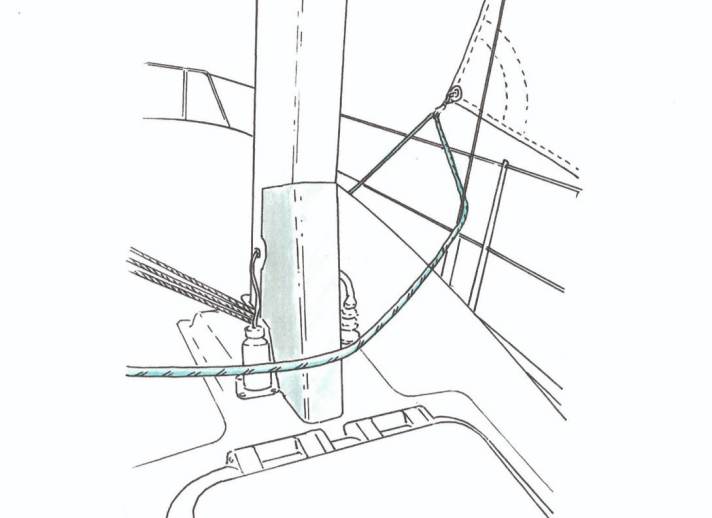
Manoeuvre lifehack 1: Stainless steel deflector protects the cables on the mast and allows the sheet to slide past

With masts standing on deck, the electrical connection to the engine light or the wind measuring system is usually established via cables coming out of the foot and corresponding deck bushings. As the boom vang is attached to the back of the mast, there is only enough space for the cables on the sides or the front. There, however, the cables are endangered by the genoa sheet, which all too easily snags on the lead-through or rubs against the cables. To solve the problem permanently, we opted for a solid stainless steel deflector. It consists of 1.5 millimetre thick stainless steel sheet, which we bent into a U-shaped profile so that it virtually extends the mast profile forwards. It is attached to the pole with four self-tapping screws, but can also be riveted on. It is important to separate the stainless steel and aluminium mast with an insulating paste to prevent galvanic corrosion.
Thomas Eggenberger, Amstetten
Manoeuvre lifehack 2: Smooth turning

It's a recurring annoyance - especially in light winds, the genoa sheet gets caught under the spinnaker pole attached to the mast or behind the gooseneck of the cable grommet almost every time you tack. Not only does it have to be cleared by hand, the gooseneck is also at risk of tearing if too much tension is applied to the sheet. The solution to this problem is a line stretched from the handrails to the mast. This simple deflector prevents the sheet from coming too close to the fittings and getting tangled behind them.
Joachim Kannengießer, Kiel
Manoeuvre lifehack 3: The round must go into the square

We often got the headsheet caught in the manoeuvre. Especially when tacking, when the overlapping headsail had already gone through the wind and the sheet was to be tightened, the triangle on the clew got caught on the shrouds. This was remedied by a piece of fabric tube about 25 centimetres long and of a suitable diameter. The sheets were guided through oval incisions. The tube is filled with a piece of rope to prevent the bow from flattening between the sheets. The tube is secured with rigging slings.
Hans Hesse, Eutin
Manoeuvre lifehack 4: Castors for the railing

Floorball or floorball balls are ideal as a deflector at the railing, as the sail or foresheet often gets caught there when tacking. The practical thing about the balls is that they already have numerous holes through which the railing wire can be passed. So no preparation or improvisation is required. And they're cheap too - the sports equipment is available in packs of five or ten for around eight euros. We drive a red ball on the port side and a green ball on the opposite side.
Helmut Koch, Brunswick
Do you have any advice for other sailors?
We will honour the publication of your lifehack with 50 euros. Please add photos or sketches. We also need your address so that we can send you a crossed cheque.
Submissions to: YACHT editorial office, Gänsemarkt 24, 20354 Hamburg; or: mail@yacht.de
